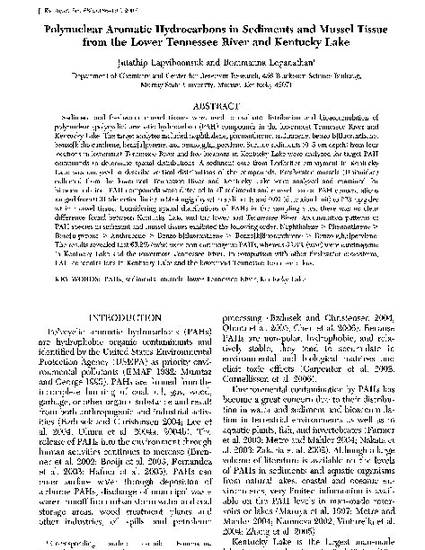
Article
Polynuclear aromatic hydrocarbons in sediments and mussel tissue from the lowermost Tennessee River and Kentucky Lake
Journal of Kentucky Academy of Science
(2007)
Abstract
Sediment and freshwater mussel tissues were used to evaluate distribution and bioaccumulation of polynuclear (polycyclic) aromatic hydrocarbon (PAH) compounds in the lowermost Tennessee River and Kentucky Lake. The target analytes included naphthalene, phenanthrene, anthracene, benzo[b]fluoranthene, benzo[k]fluoranthene, benzo[a]pyrene, and benzo[g,h,i]perylene. Surface sediments (o-5 cm depth) from four locations in lowermost Tennessee River and five locations in Kentucky Lake were analyzed for target PAH compounds to determine spatial distribution. A sediment core from Ledbetter embayment in Kentucky Lake was analyzed to describe the vertical distribution of the compounds. Freshwater mussels (Unionidae) collected from the lowermost Tennessee River and Kentucky Lake were analyzed and examined for bioaccumulation. PAH compounds were detected in all sediments and mussel tissues. PAH concentrations ranged from 0.01 (detection limit) to 90.4 ng/g dry wt in sediments and 0.02 (detection limit) to 223 ng/g dry wt in mussel tissue. Considering the spatial distribution of PAHs in the sampling sites, there was no clear difference found between Kentucky Lake and the lowermost Tennessee River. Accumulation patterns of PAH species in sediment and mussel tissues exhibited the following order: Naphthalene > Phenanthrene > Benzo[a]pyrene > Anthracene > Benzo[b]fluoranthene > Benzo[k]fluoranthene > Benzo[g,h,i]perylene. The results revealed that 66.2% (w/w) were non-carcinogenic PAHs, whereas 33.8% (w/w) were carcinogenic in Kentucky Lake and the lowermost Tennessee River. In comparison with other freshwater ecosystems, PAH concentrations in Kentucky Lake and the lowermost Tennessee River were low.
Keywords
- Kentucky Lake,
- PAHs,
- Sediments,
- Freshwater Mussel
Disciplines
Publication Date
Fall August, 2007
Citation Information
Lapviboonsuk, J.; Loganathan, B.G. 2007. Polynuclear aromatic hydrocarbons in sediments and mussel tissue from the lowermost Tennessee River and Kentucky Lake. Journal of Kentucky Academy of Science. 68, 186-197.
Creative Commons license

This work is licensed under a Creative Commons CC_BY-NC International License.
